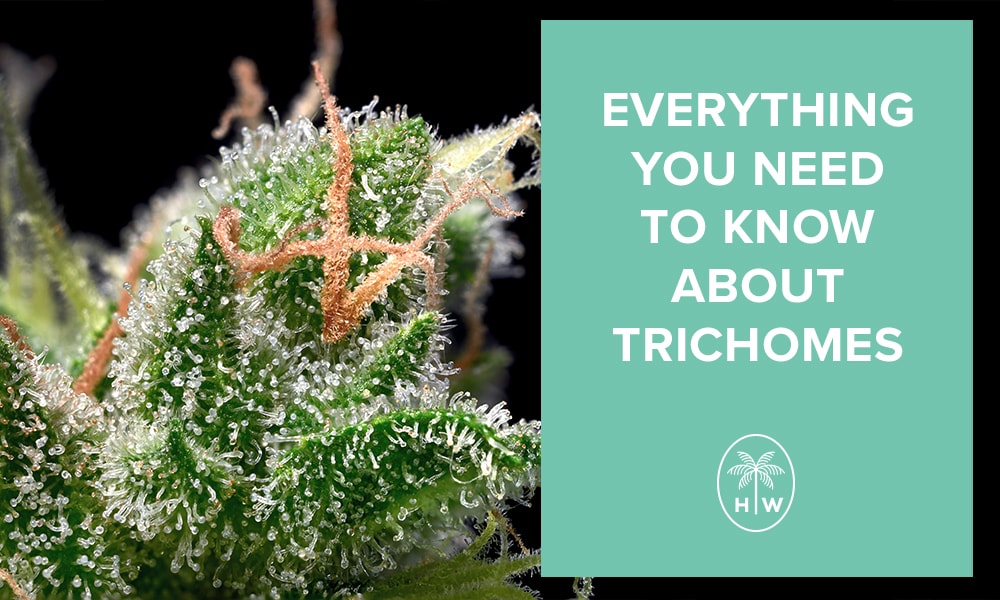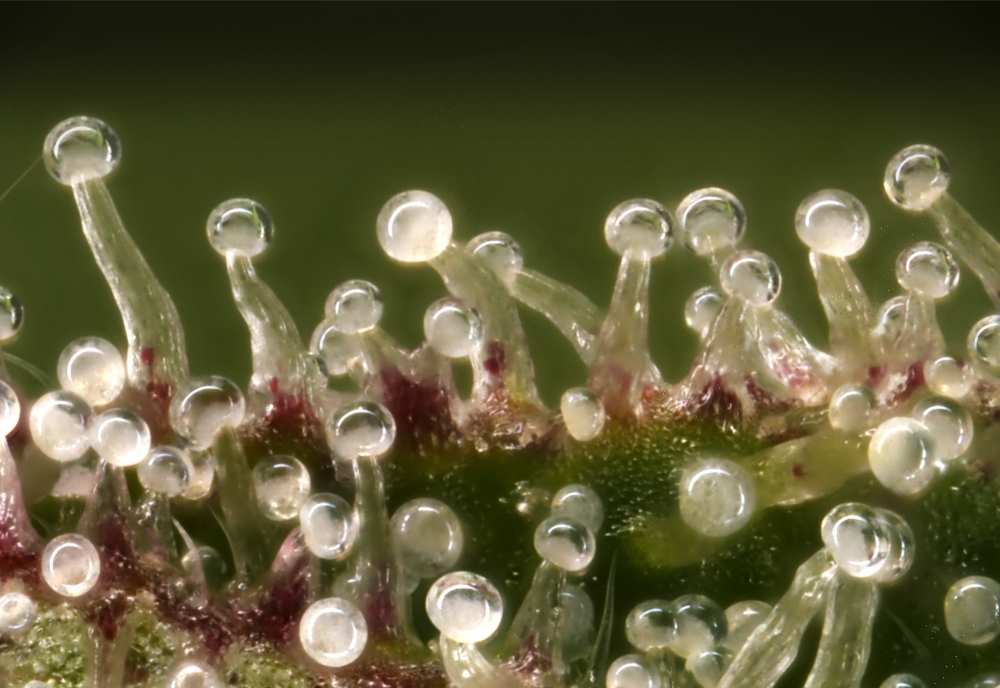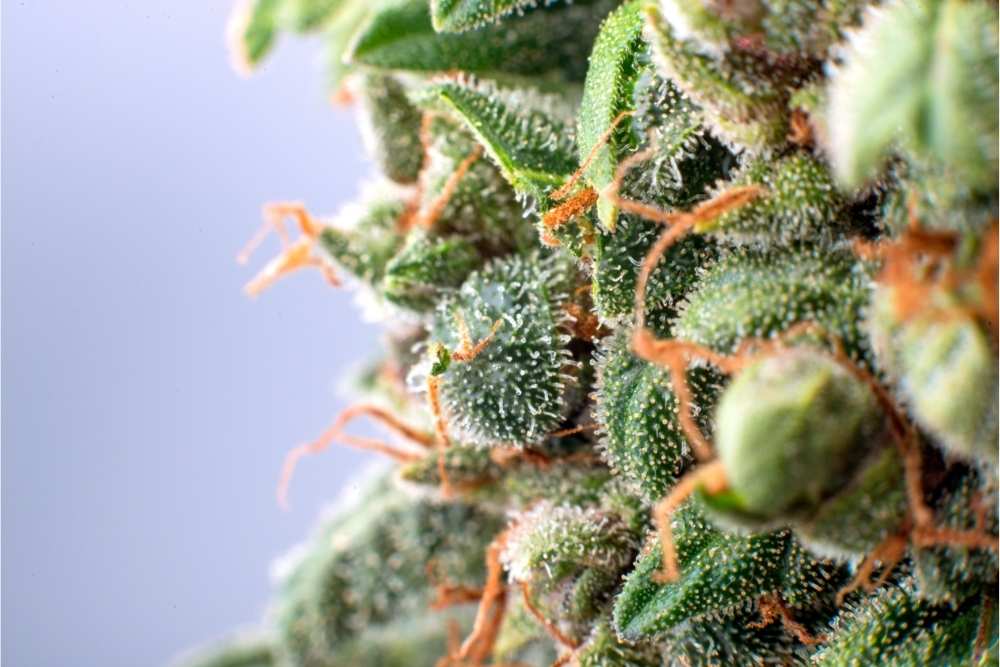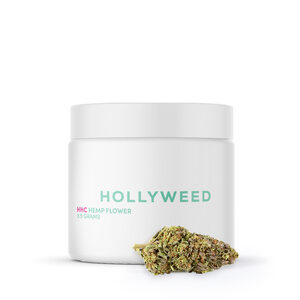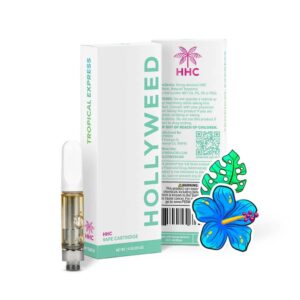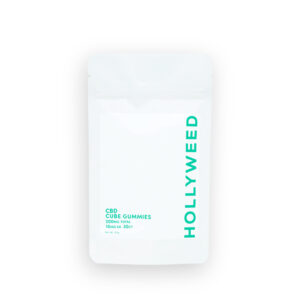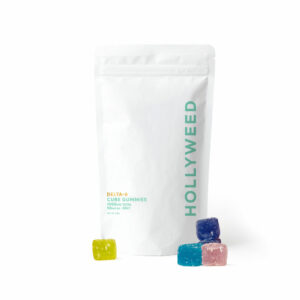Chances are you’ve seen a cannabis bud smothered in shiny and sticky crystals. No, these plants are not victims of frost or a spider infestation. These fine outgrowths of tiny hairs are trichomes. But that still doesn’t answer the nagging question: what are trichomes? If you’ve never heard of them, then you’re not alone.
The cannabis industry values trichomes for their production of terpenes and cannabinoids like CBD and THC. Not all of these little hairs are visible to the naked eye, nor are they all the same. Several different types of these crystals exist to help a cannabis plant grow and thrive. Read on to find out what makes this versatile sticky-icky-icky so valuable and an indicator of a quality cannabis product!
Table of Contents
What Are Trichomes?
Trichomes, named after the Greek word trichōma, meaning “hair,” are the crystalline outgrowths seen on cannabis plants. These tiny hairs give the cannabis flower a frosty and slimy appearance. Trichomes produce compounds unique to each cannabis plant strain and make the following compounds:
- Cannabinoids: Naturally occurring compounds found in the cannabis plant. Cannabinoids interact with the endocannabinoid system (ECS) to boost a person’s general wellness. Some popular cannabinoids include CBD, THC, and Delta 8 THC.
- Terpenes: Natural essential oils found in plants. Terpenes are responsible for the flavor profile and the strong aroma of plants.
- Flavonoids: Compounds responsible for giving a plant its color.
Cannabinoids and terpenes are of special importance in the CBD product. Physical and chemical extraction techniques separate trichomes from the plant material. Further processing yields the many cannabinoids and terpenes found in hemp industry products.
What Are Trichomes Made Of?
These crystal ends, however, are not unique to the cannabis plant. They’re also found on other plants, algae, and lichens. Trichomes have different shapes, sizes, and functions. They can be glandular and non-glandular hairs, scales, and papillae.
Trichomes begin to emerge when a cannabis plant starts to flower. The typical trichome has a thin multicellular stalk and head. The stalk consists of epidermal and hypodermic cells, which transport nutrients to secretory cells in the trichome head. These cells convert nutrients into cannabinoid and terpene precursors.
Growing Conditions For Optimal Trichome Production
Higher concentrations of trichomes don’t necessarily mean more cannabinoids and terpenes. Growing a cannabis plant under certain conditions, however, may help determine this. The main factors that impact optimal trichome production are:
- Plant strain: Certain strains of cannabis plants will produce higher amounts of trichomes.
- Light exposure: Plants exposed to a broad spectrum of light produce higher amounts of cannabinoids and terpenes.
- Heat exposure: Excess heat will hamper trichome production during all stages of growth. Low temperatures promote the production of cannabinoids from the resin glands.
- Handling: Trichomes can become compromised if buds come in contact with each other. To preserve a strain’s purity, avoid contact with other plants at all times.
- Harvesting: The color of trichomes determines the potency of the strain. Experienced cannabis growers should know exactly when to harvest their crops based on the color of trichomes.
What Do Trichomes Do?
Trichomes are the crown jewel of the cannabis plant that perform several important functions. Some of these functions are well known, while others are overlooked. Here are some of the many functions that trichomes perform.
Site of Cannabinoid Synthesis
Trichomes are the site of cannabinoid synthesis. The resin produced by trichomes is the source of a cannabis plant’s cannabinoids and terpenes. These compounds are responsible for the potency and characteristics of particular cannabis strains. A general rule of thumb for cannabis growers is the more trichomes there are, the more abundant the cannabinoids and terpenes are.
Bud Potency and Harvest Indicator
A cannabis plant’s crystal ends change color throughout a bud’s growing phase. The various colors of determine the potency of buds. They also help growers determine when to harvest them. However, depending on their intended purpose, growers can harvest buds at any stage.
The generally accepted trichome color indicators for potency and harvesting are as follows:
- Clear: Buds are too early to harvest and are still actively growing.
- Cloudy: Buds contain optimal cannabinoid levels and potency. These buds are ready for harvesting.
- Amber: The potency of the buds is strongest. The amber color may indicate deteriorating THC levels.
Protection From The Elements
These crystals help protect a cannabis plant’s integrity from the elements. Excess UV light may be detrimental to a cannabis plant’s development. Increased trichome amounts protect these plants from harmful UV rays.
These crystals also protect cannabis plants from the effects of damaging winds by providing insulation. They also serve to ward off frost.
A Plant’s Defense Mechanism
Some crystals don’t synthesize cannabinoids. Instead, they function to defend a plant from external disturbances. These types come in various shapes and sizes, ranging from straight to jagged. These defense crystals also produce secondary metabolites with repulsive properties.
These crystal ends have a bitter taste that wards off animals. Together, these defense mechanisms protect the plant from microbes, tiny insects, fungi, and animals.
Help Plants Reduce Water Loss
These crystals help reduce water loss by blocking airflow across a plant’s surface. This helps reduce water loss through transpiration and aids a plant’s growth.
Trichomes Are Not Pistils
Many mistakenly identify pistils and trichomes as the same thing. However, they couldn’t be more different. Pistils are the reproductive part of the flower in female cannabis plants. Pistils are important for two reasons:
- They help identify the sex of the cannabis plant.
- They determine when the cannabis plant is ready to harvest.
Growers monitor the colors of the pistils throughout a cannabis plant’s flowering stage. When most pistils turn red, orange, or brown, it’s time to harvest the buds.
Are All Cannabinoids Trichomes?
Nope! Not all trichomes produce cannabinoids. To know which ones do, we have to determine whether they are non-glandular or glandular.
Non-Glandular Trichomes
Non-glandulars are hair-like structures extending from the surface of cannabis plants. These crystals come in several pointed and angular shapes and sizes. The primary function of these crystals is to serve as a defense mechanism for the plant. Non-glandular types do not have the necessary biological framework to produce CBD, THC, or other cannabinoids.
Glandular Trichomes
Glandular crystal ends are the Holy Grail of the CBD industry. These produce cannabinoids and terpenes essential to hemp industry products.
All glandular types produce cannabinoids. However, the extent to which they produce cannabinoids is dependent on the type of trichome it is and its growing conditions. A 2019 study found the bigger the glandular, the more abundant the cannabinoids.
What Are the Most Common Trichomes Found in CBD?
While all these fuzzy kief particles might look the same, they are very different. These crystal bud ends range in size from 10-300 microns in size. For a size comparison, the average human hair has a width of 70 microns.
The three different variations found in cannabis plants are bulbous, capitate sessile, and capitate-stalked. Each has unique properties that differentiate one from the other.
- Bulbous trichomes: Bearing a spherical appearance to them, hence their name. Bulbous measure 10-15 microns and are only viewable microscopically. These fuzzy crystals are the smallest of the three and are found across the entire plant surface.
- Capitate sessile trichomes: Just 20-30 microns wide, Capitate sessile have a very short base with mushroom-shaped trichome heads.
- Capitate-stalked trichomes: These are the largest of the cannabis trichomes and are seen with the naked eye. Capitate-stalked range from 50-300 microns, with some as wide as 500 microns! These kief crystals get their name from their ball-shaped gland head called the capitate. Extending down from the capitate is a stalk made from epidermal and hypodermic cells.
Final Thoughts – What Are Trichomes?
Simply, they are the versatile hair-like structures found on cannabis flowers. These fine hairs are responsible for the sugar-coated look of buds. These fuzzy ends are far more versatile and serve many functions. Chief among them is the production of cannabinoids and terpenes. Experienced growers allow these flowery hairs indicate when they should harvest their flowers.
Trichomes have become a signifier of a cannabis plant’s quality and the source of the modern cannabis industry’s most popular CBD products. The next time you see a cannabis flower encrusted with glistening fuzz, you’ll know exactly where the flavor and general wellness of your favorite CBD products came from.
